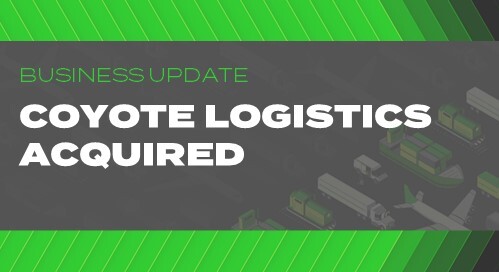Shipping Trends for December 2024: Latest Freight Market Cheat Sheet
Welcome to the Freight Market Cheat Sheet.
In this short guide, supply chain professionals (like you) can get a quick update on what’s happening in North American freight markets this month.
Get insights driven by market experts and proprietary network data.
Jump to Section:
Overview | Truckload | LTL | Intermodal
Mexico | Canada | Coyote News
Freight Market Overview
Peak season shipping is in full swing, and we’ve entered the intra-holiday period between Thanksgiving and Christmas.
We are also in a new truckload market cycle (according to our Curve forecast), and while we haven’t experienced a huge upswing in freight market rates, the holidays are driving some increased activity.
Let’s look at a few trends before diving into rates and modes.
Black Friday & Cyber Monday drove increased volumes
The week following Thanksgiving generally sees volumes spike, spurred by the flood of ecommerce demand from Black Friday and Cyber Monday.
We saw this play out again this year, as truckload demand increase, however, so did capacity, after carriers took a few well-deserved days off.
While there was some volatility, overall the supply/demand balance remained relatively stable.
Spot rates moderated post-holiday
Overall, we saw decrease of 2.1% in spot rates for the week following Thanksgiving.
Looking at the prior two years, we saw rates come down by ~ 1%, so there was a slight outperformance this year.
With Thanksgiving two weeks in the rearview, we can state that it had less dislocation overall than in prior years.
More to come as Christmas approaches
Though the spot market is barely above the pre-holiday baseline, it did still reset with a higher baseline (2%-3%).
Furthermore, with more holiday shipping coming up throughout December, it is likely to keep pushing higher deeper into the month.
Full Truckload Trends: December 2024
In November, we saw overall truckload rates climb 2.4% month-over-month (M/M), trending up slightly after several weeks of stagnation.
Looking at equipment types, dry van (1.8%) went up a notch, refrigerated moved up 3.5%, and open deck moved down -1.6%. Looking at year-over-year (Y/Y) comparisons, we continued our venture into inflationary territory in total (12.0%), dry van (12.0%), reefer (12.3%), and flatbed (4.7%).
Note on the data: all truckload rate figures are derived from Coyote’s proprietary transactional data. With thousands of daily shipments, it is one of the largest centralized freight marketplaces in North America.
LTL Trends: December 2024
LTL merger & acquisition activity
Knight-Swift completes Dependable Highway Express acquisition
Knight-Swift, traditionally a truckload-focused carrier, continues to build out their national LTL footprint. This started with AAA Cooper, who was primarily a southeast carrier, followed by Midwest Motor Express. Most recently, Knight-Swift completed the acquisition of Dependable Highway Express, giving them California, Arizona, and Nevada coverage.
AAA Cooper, Midwest Motor Express, and Dependable Highway Express (DHE) are now fully integrated into one operating system. In CoyoteGO, DHE lanes will now populate as AAA Cooper and will move on their SCAC (AACT).
Moran Transportation acquired RMX Freight Systems
Moran Transportation has acquired RMX Freight Systems. RMX had full coverage of Ohio and partial coverage in Michigan and West Virginia.
This blends with Moran’s existing coverage throughout Illinois, Indiana, Wisconsin, Minnesota, Missouri, North Dakota, and South Dakota. They also offer cross-border coverage to western Canada.
Results from recent LTL customer survey
Mastio conducts an annual study of LTL shippers and recently released their 2024 findings, based on interviews from 1,608 shippers.
In the overall rankings, Daylight Transport finished first, followed by Averitt, Old Dominion, Peninsula, and Dayton Freight.
The top carriers in their respective regions were Ward, Southeastern Freightlines, Dayton Freight, and Peninsula.
Changes coming to NMFC classifications in 2025
The NMFTA is in the process of making changes to the NMFC classification system. Changes will not go into effect until May of next year, but it is going to impact many shippers.
NMFTA initially announced they would be changing over 5,000 NMFC item numbers to a density-based scale. The most recent update listed over 3,000 of those items as Out of Scope for the 2025-1 docket. Reviews are ongoing and the final list will be available in January.
Here’s a timeline of the changes:
- January 2025: Docket 2025-1, a list of NMFC items that are potentially going to change, will be available for review.
- March 2025: The NMFTA will hold a public meeting to discuss the changes.
- May 2025: NMFC changes will go into effect.
To stay updated, visit the 2025 NMFC Changes page on the NMFTA site.
Intermodal Trends: December 2024
Intermodal volumes remain strong
Through the first 11 months of 2024, North American intermodal volume is up 7.4% Y/Y, and up 9.1% Y/Y in the United States, specifically.
Furthermore, volume continued to climb well into mid-November, which is later into the month than is typical for peak season. This was likely driven by increases in import volume, as many customers continue to “pull ahead” shipments ahead of 2 key dates:
- January 15th: the ILA dockworkers on the U.S. east & gulf coasts could potentially strike (again) if their new contract isn’t ratified
- January 20th: inauguration date of President-Elect Trump, who has proposed new tariffs on imported goods.
Rates tick up slightly (but still competitive to truckload)
As a result of the inventory pull through, intermodal spot rates have continued to creep upward, particularly out of the Los Angeles metro.
As we get further into the 2024-25 RFP season, most railroads are forecasting Y/Y contract rate increases in the mid-to-high single-digit percent range. However, shippers who are able to lock in an annual contract in the coming months before the truckload market shifts will likely get better savings vs. truckload in 2025.
Service held steady throughout the year
Looking back at 2024, we can acknowledge that intermodal service was resilient in the face of multiple disruptive events (rail strike in Canada, three major hurricanes, the ILA struck every east coast port, lockouts in Western Canadian ports and Montreal).
Despite the potential for disruption, there was no network-wide service meltdown. That hasn’t always been the case (see 2020-through-early-2022 for reference).
As we look back on 2024 and prepare to ring in the new year 2025, there is every reason to expect that intermodal service will continue to shine as a cost-effective alternative to over-the-road trucking.
Related: Intermodal vs. Truckload: 4 Things Every Shipper Should Know
Cross-Border Mexico Trends: December 2024
For the second straight month, overall rates dropped (-2.8% in November), with northbound rates increasing by 2.1% M/M, but offset by southbound rates dropping by -9.4% M/M.
Year-over-year, rates were down across the board: -7.1% total, -1.2% for northbound shipments and -17.2% for southbound.
Note on the data: all truckload rate figures are derived from Coyote’s proprietary transactional data. With thousands of daily shipments, it is one of the largest centralized freight marketplaces in North America.
Related: How to Ship U.S.-Mexico Cross-Border Freight
Cross-Border Canada Trends: December 2024
In November, overall rates were flat M/M, with northbound increasing 0.5% and southbound decreasing -0.5%. Y/Y rates were down slightly (-2.1% overall).
Note on the data: all truckload rate figures are derived from Coyote’s proprietary transactional data. With thousands of daily shipments, it is one of the largest centralized freight marketplaces in North America.
Winter is here
We’ve now experienced a handful of storms, leading to snowy and icy road conditions. As a shipper, try to be proactive (e.g., tender shipments three to five days in advance) and flexible during the winter months as the weather can cause capacity issues. This is especially true if you have temperature-sensitive freight requiring protect-from-freeze.
Related: How to Ship U.S.-Canada Cross-Border Freight
RXO News
Stay up to date with RXO.
- RXO acquired Coyote Logistics. Learn more about how the combined company will bring value to shippers and carriers.
- RXO Earns 2024 Top Software and Tech Award
- RXO Announces Participation at Upcoming Investor Conferences
- RXO Reports Third-Quarter Results
- RXO Named Top Company for Women to Work for in Transportation
Want the Cheat Sheet as a PDF?
Fill out this brief form to download a PDF of the latest Freight Market Cheat Sheet for quick reference.







